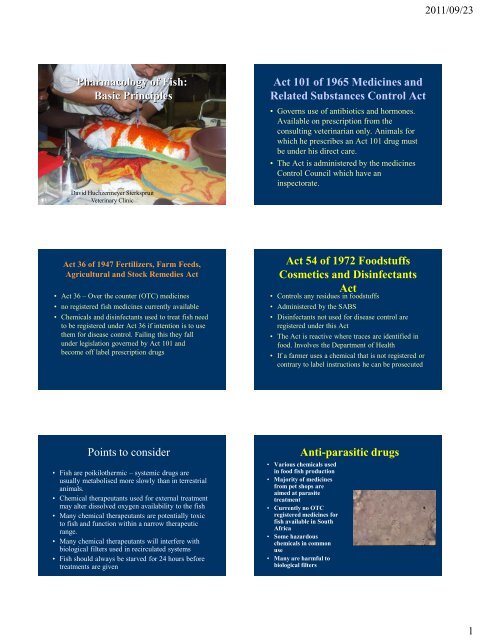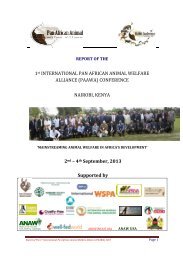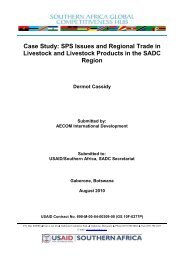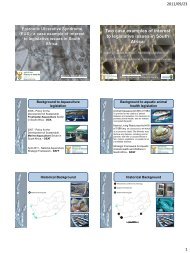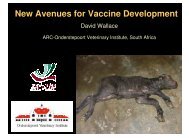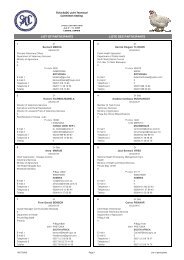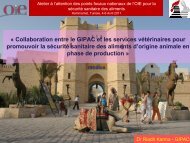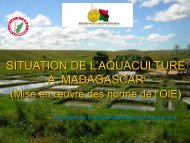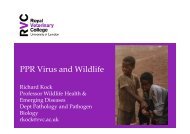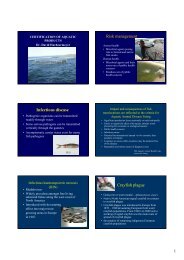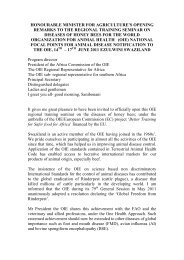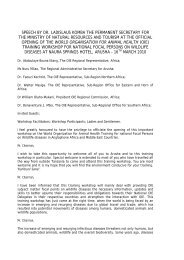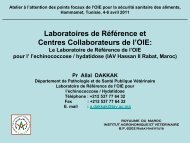Pharmacology of Fish: Basic Principles Act 101 of 1965 ... - OIE Africa
Pharmacology of Fish: Basic Principles Act 101 of 1965 ... - OIE Africa
Pharmacology of Fish: Basic Principles Act 101 of 1965 ... - OIE Africa
You also want an ePaper? Increase the reach of your titles
YUMPU automatically turns print PDFs into web optimized ePapers that Google loves.
2011/09/23<br />
<strong>Pharmacology</strong> <strong>of</strong> <strong>Fish</strong>:<br />
<strong>Basic</strong> <strong>Principles</strong><br />
David Huchzermeyer Sterkspruit<br />
Veterinary Clinic<br />
<strong>Act</strong> <strong>101</strong> <strong>of</strong> <strong>1965</strong> Medicines and<br />
Related Substances Control <strong>Act</strong><br />
• Governs use <strong>of</strong> antibiotics and hormones.<br />
Available on prescription from the<br />
consulting veterinarian only. Animals for<br />
which he prescribes an <strong>Act</strong> <strong>101</strong> drug must<br />
be under his direct care.<br />
• The <strong>Act</strong> is administered by the medicines<br />
Control Council which have an<br />
inspectorate.<br />
<strong>Act</strong> 36 <strong>of</strong> 1947 Fertilizers, Farm Feeds,<br />
Agricultural and Stock Remedies <strong>Act</strong><br />
• <strong>Act</strong> 36 – Over the counter (OTC) medicines<br />
• no registered fish medicines currently available<br />
• Chemicals and disinfectants used to treat fish need<br />
to be registered under <strong>Act</strong> 36 if intention is to use<br />
them for disease control. Failing this they fall<br />
under legislation governed by <strong>Act</strong> <strong>101</strong> and<br />
become <strong>of</strong>f label prescription drugs<br />
<strong>Act</strong> 54 <strong>of</strong> 1972 Foodstuffs<br />
Cosmetics and Disinfectants<br />
<strong>Act</strong><br />
• Controls any residues in foodstuffs<br />
• Administered by the SABS<br />
• Disinfectants not used for disease control are<br />
registered under this <strong>Act</strong><br />
• The <strong>Act</strong> is reactive where traces are identified in<br />
food. Involves the Department <strong>of</strong> Health<br />
• If a farmer uses a chemical that is not registered or<br />
contrary to label instructions he can be prosecuted<br />
Points to consider<br />
• <strong>Fish</strong> are poikilothermic – systemic drugs are<br />
usually metabolised more slowly than in terrestrial<br />
animals.<br />
• Chemical therapeutants used for external treatment<br />
may alter dissolved oxygen availability to the fish<br />
• Many chemical therapeutants are potentially toxic<br />
to fish and function within a narrow therapeutic<br />
range.<br />
• Many chemical therapeutants will interfere with<br />
biological filters used in recirculated systems<br />
• <strong>Fish</strong> should always be starved for 24 hours before<br />
treatments are given<br />
Anti-parasitic drugs<br />
• Various chemicals used<br />
in food fish production<br />
• Majority <strong>of</strong> medicines<br />
from pet shops are<br />
aimed at parasite<br />
treatment<br />
• Currently no OTC<br />
registered medicines for<br />
fish available in South<br />
<strong>Africa</strong><br />
• Some hazardous<br />
chemicals in common<br />
use<br />
• Many are harmful to<br />
biological filters<br />
1
2011/09/23<br />
Drugs against external<br />
protozoan infections -<br />
FORMALIN<br />
• Good all-purpose<br />
parasiticide and<br />
disinfectant<br />
• Deoxygenating effect.<br />
Use with care in fish<br />
with gill disease and<br />
anaemia<br />
• Avoid white deposit that<br />
forms as formalin ages.<br />
This is<br />
PARAFORMALDE-<br />
HYDE and is extremely<br />
toxic to fish<br />
• Effective against<br />
external protozoa<br />
• Therapeutic dose lies<br />
close to toxic level<br />
• Use neutral acriflavine<br />
• Produces temporary<br />
sterility in both egg<br />
laying and livebearing<br />
fish<br />
• Toxic to some plants<br />
• Can be used in sea water<br />
Acriflavine<br />
Potassium permanganate<br />
• Good disinfecting<br />
properties<br />
• Rapidly destroyed by<br />
organic material<br />
• Can be used for<br />
emergency oxygenation<br />
• Treatment <strong>of</strong> external<br />
protozoal and<br />
monognean parasites<br />
and bacterial gill disease<br />
• Avoid use with scaleless<br />
fish<br />
• Effective against<br />
external fungal and<br />
protozoal infection<br />
• Increases respiratory<br />
capacity <strong>of</strong> fish<br />
• At high doses useful<br />
in sea water<br />
• Use only pure grades<br />
• Toxic to scaleless fish<br />
Methylene blue<br />
Drugs against external<br />
monogenean flukes<br />
• Formalin – gill flukes<br />
• Potassium<br />
permanganate<br />
• Organophosphates,<br />
dichlorphos and<br />
trichlorphon<br />
• Benzimadozoles,<br />
particularly<br />
• Mebendazole<br />
• Praziquantel<br />
Drugs against external copepods<br />
• Traditionally dichlorphos<br />
and trichlorphon have<br />
been used, particularly by<br />
the salmon industry<br />
against Lepeophtheirus<br />
and Caligus sea lice<br />
• Dimilin (diflubenzaron)<br />
very effective and safe in<br />
freshwater<br />
Argulus – fish louse<br />
Lernaea cyprini – anchor worm<br />
2
2011/09/23<br />
Malachite green<br />
Malachite green<br />
• Used only in non-food<br />
producing fish<br />
• Banned for use in food<br />
fish in western countries<br />
• Teratogenic<br />
• Traditionally used to<br />
prevent fungal<br />
overgrowth <strong>of</strong> salmonid<br />
eggs<br />
• Useful against external<br />
protozoa in combination<br />
with formalin.<br />
• Only the zinc free form is safe for use in fish<br />
• Respiratory poison in fish – mitochondrial enzyme<br />
inhibitor<br />
• Affinity for organic matter, then oxidised in<br />
presence <strong>of</strong> air and light<br />
• In water MG gradually changes to the colourless<br />
carbinol form<br />
• Penetrates tissues more deeply than previously<br />
anticipated<br />
• Parenteral<br />
• In feed<br />
• No registered antibiotics<br />
for use in food fish in<br />
South <strong>Africa</strong><br />
• Correct dispensing<br />
procedure<br />
• Off-label use, <strong>Act</strong> <strong>101</strong><br />
• Limitation – sick fish stop<br />
feeding!<br />
Antibiotics<br />
Antibiotics<br />
• Establish that infection is caused by a<br />
bacterial pathogen<br />
• Identify the pathogen involved and<br />
determine the antibacterial sensitivity<br />
• Start treatment as soon as possible<br />
• Reduce stocking density and improve pond<br />
hygiene<br />
• Avoid prophylactic use <strong>of</strong> antibiotics<br />
Antibiotics<br />
Antibiotics<br />
• For environmental and food safety reasons<br />
veterinarians should encourage farmers to follow<br />
protocols that minimize reliance on antibiotics for<br />
production <strong>of</strong> food fish species.<br />
• Drug elimination times vary with water<br />
temperature. A minimum <strong>of</strong> 4 weeks withdrawal<br />
should be maintained in the absence <strong>of</strong> specific<br />
elimination data.<br />
• Oxytetracycline and amoxycillin most commonly<br />
used in South <strong>Africa</strong>.<br />
Oxytetracycline<br />
• 75 mg/kg daily for 10<br />
days<br />
• Withdrawal period<br />
350 degree days for<br />
rainbow trout<br />
Amoxycillin<br />
• 40-80 mg/kg daily for<br />
10 days<br />
• Withdrawal period<br />
150 degree days in<br />
atlantic salmon<br />
3
2011/09/23<br />
Other antibiotics<br />
• Florfenicol (Nuflor) – very effective in fish.<br />
Registered for use in fish in countries other than<br />
South <strong>Africa</strong><br />
• Erythromycin – not readily availabe for fish in<br />
South <strong>Africa</strong>. Used elsewhere<br />
• Nifurpirinol (Furanace) – banned from use in fish<br />
• Chloramphenicol – banned from use in fish<br />
Antibiotics<br />
• Antibiotic medicated feed is given daily for<br />
10 days.<br />
• Daily feed is reduced by 50 %<br />
• Vegetable oil is used at 10 % <strong>of</strong> daily feed<br />
to mix the daily dose <strong>of</strong> medication<br />
• Oil and antibiotic mixture is top dressed<br />
onto feed<br />
• <strong>Fish</strong> are treated daily for 10 days<br />
Drugs against bacterial<br />
infections<br />
• Benzalkonium chloride<br />
- cationic surface-active<br />
agent and germicide<br />
- Causes shedding <strong>of</strong> mucus<br />
layer from skin and gills<br />
- Chemicals effective<br />
against external protozoal<br />
infections all have some<br />
disinfectant properties<br />
Drugs used against external<br />
fungal (oomycete) infections<br />
• Malachite green<br />
• Methylene blue<br />
• Bromopol (Pyces)<br />
registered in UK,<br />
alternative to MG<br />
• Formalin<br />
• Hydrogen peroxide<br />
Drugs used to manipulate<br />
breeding<br />
• Pituitary gland extract<br />
• Gonadotrpin relasing hormones – synthetic<br />
analogue, Aquaspawn (has restricted<br />
registration under <strong>Act</strong> 36 – use only under<br />
direction <strong>of</strong> veterinarian or fish scientist)<br />
• HCG<br />
Drugs used to manipulate sex<br />
<strong>of</strong> <strong>of</strong>f-spring<br />
• Methyl testosterone used in minute<br />
quantities in feed <strong>of</strong> first feeding trout fry<br />
• 3 mg hormone per kg <strong>of</strong> food<br />
• Swim-up fry are fed hormone medicated<br />
feed for 750 degree days<br />
• Results in genotypic females expressing<br />
male phenotype and producing ductless<br />
seminiferous tissue in place <strong>of</strong> ovaria<br />
4
2011/09/23<br />
Production <strong>of</strong> all female stock<br />
• Sex reversed male fish produce only ‘X’<br />
chromosome carrying sperm<br />
• When used to fertilize ova all <strong>of</strong>fspring are ‘XX’ –<br />
female<br />
• Sterile triploid fish can be produced if the<br />
fertilized ova are exposed to high pressure<br />
• Common practice in a few trout hatcheries in<br />
South <strong>Africa</strong><br />
• Potential for use in tilapia hatcheries.<br />
Anaesthetics and tranquilizers<br />
primarily used to minimize stress during<br />
handling procedures<br />
Stages<br />
• I loss <strong>of</strong> equilibrium<br />
• II loss <strong>of</strong> gross body movements but with<br />
regular opercular movements<br />
• III as in stage II with cessation <strong>of</strong> opercular<br />
movement<br />
Anaesthetics<br />
Physiological changes<br />
• Reflect hypoxia<br />
• Fall in PO 2<br />
• Increase in PCO 2<br />
• Decline in blood pH<br />
• Cortisol concentrations decline<br />
• Adrenalin increases but declines during recovery<br />
• Transient increase in haematocrit<br />
Anaesthetics<br />
• Benzocaine<br />
• Tricaine methane sulphonate (MS222)<br />
• Quinaldine<br />
• 2 phenoxyethanol<br />
• Propoxate<br />
• Eugenol 30 mg/L<br />
• Metomidate<br />
Disinfectants<br />
• Potentially lethal to fish<br />
• Hatchery equipment – chlorine, formalin<br />
• Nets – benzalkonium chloride<br />
• Footbaths – iodine<br />
• Earthen ponds – quicklime or slaked lime<br />
• Concrete ponds – sodium hydroxide plus<br />
teepol<br />
<strong>Fish</strong> medicines<br />
• Must be demonstrably effective<br />
• Safe to the - target animal<br />
- consumer<br />
- environment<br />
5
2011/09/23<br />
Registration <strong>of</strong> medicines<br />
Medicinal product definition<br />
• Scientific assessment <strong>of</strong> data supplied by<br />
applicant<br />
• Statutory criteria for safety, quality and<br />
efficacy<br />
• Positive risk:benefit ratio<br />
Verner-Jeffreys, D., Algoet, M. (2005) Trout News 39<br />
• Any substance or combination <strong>of</strong> substances<br />
presenting as having properties for treating or<br />
preventing disease; or any substance or<br />
combination <strong>of</strong> substances which may be used in,<br />
or administered to, animals with a view either to<br />
restoring, correcting or modifying physiological<br />
functions by exerting a pharmacological,<br />
immunological or metabolic action, or to making a<br />
medicinal diagnosis (EEC Directive 2001/82/EC)<br />
Illegal use <strong>of</strong> fish medicinal<br />
products<br />
• Available in pet shops and through the<br />
Internet<br />
• Available OTC’s for non aquatic animals<br />
under <strong>Act</strong> 36 <strong>of</strong> 1947<br />
Absence <strong>of</strong> registered fish<br />
products<br />
• Prescribing cascade for the veterinarian<br />
• Veterinarian must have responsibility for<br />
the care <strong>of</strong> the aquatic animals concerned<br />
• Where no medicine is registered for a<br />
particular condition administer in<br />
accordance to <strong>of</strong>f-label provision under <strong>Act</strong><br />
<strong>101</strong> <strong>of</strong> <strong>1965</strong><br />
“Off-label use” cascade<br />
• A medicine registered for use in another<br />
species or for a different use in the same<br />
species<br />
• A medicine registered for human use<br />
• A medicine made up by the veterinarian on<br />
a one-<strong>of</strong>f basis or by a properly authorized<br />
person to the veterinarians specifications<br />
Verner-Jeffreys, D., Algoet, M. (2005) Trout News 39<br />
Food-producing animals<br />
• Off-label medicines used may only contain<br />
substances found in medicine registered for<br />
a food-producing species<br />
• When a non registered medicine is used a<br />
withdrawal period <strong>of</strong> 500 degree days must<br />
be applied<br />
• The veterinarian must keep specified<br />
records<br />
Verner-Jeffreys, D., Algoet, M. (2005) Trout News 39<br />
6
2011/09/23<br />
Commercial chemicals<br />
• Widely available (eg. formalin, malachite<br />
green, methylene blue)<br />
• Not marketed as medicines<br />
• Unregulated medicinal use<br />
• Concerns over safety to the user, the animal,<br />
the environment and the consumer<br />
• Use <strong>of</strong> commercial chemicals for medicinal<br />
purpose is illegal<br />
Feed additives (EC1831/2003)<br />
• Substances that are microorganisms or<br />
preparations <strong>of</strong> microorganisms, other than<br />
feed material and premixes, that are<br />
intentionally added to feed or water in<br />
order to perform one or more <strong>of</strong> the<br />
following:<br />
Verner-Jeffreys, D., Algoet, M. (2005) Trout News 39<br />
Feed additive (EC1831/2003)<br />
• Favourably affect the characteristics <strong>of</strong>:<br />
feed, animal products, the colour <strong>of</strong> ornamental<br />
fish and birds, the environmental consequences <strong>of</strong><br />
animal production, animal production,<br />
performance or welfare, particularly by affecting<br />
gastrointestinal flora or digestibility <strong>of</strong> feeding<br />
stuffs<br />
• Satisfy the nutritional needs <strong>of</strong> animals<br />
• Have a coccidiostatic or histomonostatic effect<br />
Feed additives<br />
• Regarded as medicines if certain product<br />
claims are made<br />
• Prebiotics and probiotics<br />
• Immunostimulants and stress relievers<br />
Verner-Jeffreys, D., Algoet, M. (2005) Trout News 39<br />
Prebiotics and probiotics<br />
• Prebiotics – nutrients added to feed to<br />
selectively stimulate populations <strong>of</strong> bacteria<br />
in the gut that are already present and<br />
established<br />
• Probiotics – in aquaculture are live<br />
microbial cultures added to rearing systems<br />
through feed or water, which improve the<br />
performance <strong>of</strong> the cultured animals<br />
Immunostimulants<br />
• If sold with health promoting claims then<br />
need to be registered as medicines<br />
7


